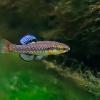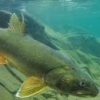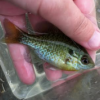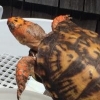I guess this could apply to any fish and not merely natives, but...what are some basic tips you guys have for breeding fish in general? I have had awful luck breeding mine, even including my swamp guppies, and in view of how uncommon most natives are in the hobby I don't want to spend a potentially substantial amount of money on the fish and then fail to breed them. Any tips for the novice fish breeder?

On the basics of breeding fish...
#1

Posted 24 February 2016 - 02:19 PM
#2

Posted 24 February 2016 - 05:23 PM
Clean water, proper temp and chemistry for that species, adequate space, dense plants, diverse diet of good quality foods, and patience. Once you have free-swimming fry, feeding fresh-hatched brine shrimp usually gives the best survival and growth.
Gerald Pottern
-----------------------
Hangin' on the Neuse
"Taxonomy is the diaper used to organize the mess of evolution into discrete packages" - M.Sandel
#3

Posted 24 February 2016 - 08:32 PM
Here's a few fish I've bred with how I did it:
-Lucania goodei: 2 adults (1M:1F) 10 gallon clear Rubbermaid shoebox in front of an outdoor window (for natural lighting, heating, and exposure to natural daylight cycles) with a 4" substrate of white pea gravel (substrate didn't really matter, just didn't want to throw that specific stuff away and didn't have any room to store it) with a green yarn spawning mop in the back corner and large pieces of hornwort floating throughout the bin (you'd be shocked how large hornwort grows with all natural lighting, the leaves were 3" long in certain places). Fed them frozen bloodworms, frozen mysis shrimp, and live blackworms. Spawned naturally without any other effort in a couple weeks but yielded only about half a dozen fry which were recently eaten by some hungry catfish in the same tank as them (never trust a catfish...).
-Gambusia affinis: 3 adults (1M:2F) 1 gallon plastic tank with 6 hours of fluorescent light. Decor included a spawning mop made of green yarn. Fed live blackworms and frozen bloodworms. Spawned without any other effort within a couple days yielding about 30 fry.
-Xiphophorus helleri: 5 adults (1M:4F) 10 gallon regular tank with 12 hours of fluorescent lights. Decor included driftwood and live plants such as Java moss, crypts, and anubias. Tank mates included a male Betta, 3 galaxy wood catfish, and 6 corydoras. Water temp sat at 78° and water changes of 50% were made every other day with the new water being 72-76°. Spawned naturally (usually after a good water change) yielding 10-50 fry per female. Not sure how many the catfish would eat overnight but the plants protected most of them until I had time to remove them to another tank.
That's just a few easier species I've spawned. If you're wondering about anything in particular, let us know, lots of knowledgeable people here!
#4

Posted 25 February 2016 - 12:38 AM
Well, OK Josh - start with livebearers. Even Damnbusia will do. It will give you some good experience with rearing fry, and the spawning itself is accomplished without any participation on your part. The thing here is to keep the parents from eating the fry - you can use a tank full of hornwort as already mentioned, or use can use a breeding trap (DIY works fine, or you can buy one). You will get a certain amount of satisfaction from raising the fry and you will gain confidence for future endeavors.
-The member currently known as Irate Mormon
#5

Posted 25 February 2016 - 03:23 AM
1: Match natural habitat of fish, provide cover, keep water clean, and generally make fish happy.
2: Condition with frozen food, or if possible, live.
3: Be sure you have a good m/f ratio- with livebearers you want one male per several females, some species prefer to be in m/f pairs, some prefer to be in groups to spawn.
4: Ensure safety of eggs and fry- provide cover/substrate and remove all non-caregiving fish.
5: Be sure you have small enough food for fry- many easier species will eat just powdered flake food, but tiny live foods are good, and plenty of moss with critters inside is also a good idea.
6: Give fry clean water, good food, plenty of room, and as little competition as possible.
7: Done!
Or, for livebearers of most types:
1: Provide adequate care.
2: Have males and females.
3: Have some amount of cover.
4: Tada!
I'd suggest the previous method for livebearers if you want to have a lot of healthy fry, but this also works, as any guppy owner will attest.
Edited by Betta132, 25 February 2016 - 03:26 AM.
#6

Posted 26 February 2016 - 04:43 PM
As others suggested, start with livebearers.... but I would NOT suggest Gambusia, AKA aggressive grey guppies
For native species (of livebearers), I would most strongly suggest Least Killifish (Heterandria Formosa)... keep as a single species group in a tank of at least 10 gallons (They breed chaotically, a 5 gallon would not suffice for dedicated breeding)
"All good things must come to an end, but bad things think thats rather dull, so they stick around long after their natural end has come"
-From an art book I read
#7

Posted 26 February 2016 - 05:47 PM
Elassoma breed well if fed enough frozen or live food.
#8

Posted 01 March 2016 - 06:07 PM
Elassoma breed well if fed enough frozen or live food.
As a certain someone (who shall not be named) informed us with a great outpouring of prose, photographs, charts, weblinks, etc...
-The member currently known as Irate Mormon
0 user(s) are reading this topic
0 members, 0 guests, 0 anonymous users













